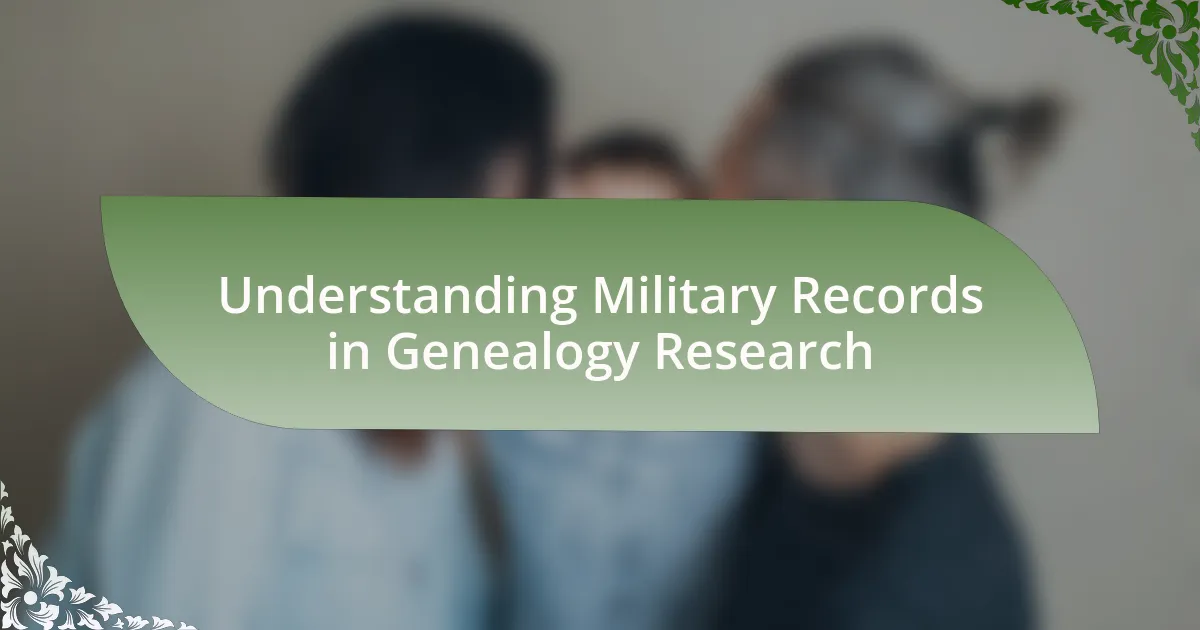The article examines the evolution of family history research, highlighting the transition from traditional paper records to digital archives. It details the historical reliance on physical documents such as birth and marriage certificates, and the impact of the internet and genealogy websites like Ancestry.com and FamilySearch.org in revolutionizing access to genealogical information. The discussion includes the role of technological advancements, such as DNA testing, in enhancing research capabilities, as well as the challenges posed by data accuracy and accessibility in the digital age. Key milestones in this evolution, along with best practices for effective research, are also addressed, providing a comprehensive overview of how family history research has transformed over time.
What is the Evolution of Family History Research?
The evolution of family history research has transitioned from reliance on paper records to the utilization of digital archives. Initially, family historians depended on physical documents such as birth and marriage certificates, census records, and church registries, which were often stored in local archives or libraries. With the advent of the internet in the late 20th century, online databases emerged, allowing researchers to access a wider array of records from home.
The launch of genealogy websites like Ancestry.com and FamilySearch.org in the early 2000s revolutionized the field by providing searchable databases and user-friendly interfaces. These platforms have digitized millions of records, making them accessible to a global audience. Additionally, advancements in technology, such as DNA testing, have further enhanced family history research by enabling individuals to uncover genetic connections and ancestral origins.
This shift from traditional methods to digital resources has significantly increased the efficiency and scope of family history research, allowing for more comprehensive and collaborative exploration of genealogical data.
How has family history research changed over time?
Family history research has evolved significantly from traditional paper records to digital archives. Initially, genealogists relied on physical documents such as birth and death certificates, census records, and family bibles, which required extensive manual searching in libraries and archives. With the advent of the internet and digital technology, databases like Ancestry.com and FamilySearch emerged, allowing researchers to access vast amounts of information online. This transition has not only increased the speed and efficiency of research but also expanded access to global records, enabling individuals to trace their ancestry across borders. The digitization of records has also facilitated the use of advanced tools like DNA testing, which provides additional insights into familial connections and heritage.
What were the primary methods of family history research before digital archives?
The primary methods of family history research before digital archives included the use of paper records, oral histories, and physical archives. Researchers relied heavily on documents such as birth, marriage, and death certificates, which were often stored in local government offices or churches. Oral histories played a crucial role, as individuals would gather information from family members, recounting stories and details that were not documented. Additionally, researchers frequently visited libraries and historical societies to access census records, land deeds, and other historical documents, which were essential for constructing family trees and understanding lineage. These methods were foundational in genealogy before the advent of digital resources.
How did technological advancements influence family history research?
Technological advancements significantly transformed family history research by enabling access to vast digital archives and databases. The introduction of online genealogy platforms, such as Ancestry.com and FamilySearch, has allowed researchers to easily search and retrieve historical records, including birth, marriage, and death certificates, which were previously only available in physical archives. Additionally, advancements in DNA testing technology have provided individuals with the ability to uncover genetic connections and ancestral origins, further enriching family history research. These innovations have democratized access to genealogical information, making it more efficient and comprehensive for researchers worldwide.
Why is understanding the evolution of family history research important?
Understanding the evolution of family history research is important because it highlights the transition from traditional methods to modern digital approaches, which significantly enhance accessibility and efficiency. Historically, family history research relied on paper records, which were often limited in availability and difficult to navigate. The shift to digital archives has democratized access to genealogical information, allowing individuals to explore their ancestry from anywhere in the world. For instance, the rise of online databases and DNA testing services has revolutionized the field, enabling millions to uncover their heritage more easily than ever before. This evolution not only reflects technological advancements but also emphasizes the growing importance of preserving cultural heritage in a digital age.
What insights can be gained from studying past research methods?
Studying past research methods reveals the progression and transformation of family history research techniques, highlighting the shift from manual documentation to digital archiving. This evolution demonstrates how advancements in technology have improved data accessibility and accuracy, allowing researchers to compile comprehensive family histories more efficiently. Historical methods, such as the use of census records and parish registers, provide context for understanding the limitations and challenges faced by earlier researchers, such as data scarcity and the labor-intensive nature of record-keeping. Analyzing these methods also underscores the importance of adapting research strategies to incorporate new tools and technologies, ultimately enhancing the quality and depth of genealogical research.
How does this evolution impact current research practices?
The evolution from paper records to digital archives significantly enhances current research practices by increasing accessibility and efficiency. Digital archives allow researchers to access vast amounts of data remotely, reducing the time and resources needed to locate and analyze family history information. For instance, platforms like Ancestry.com and FamilySearch provide extensive databases that can be searched quickly, enabling researchers to uncover connections and historical context more effectively than traditional methods. This shift has also led to the development of new analytical tools and techniques, such as data mining and machine learning, which further streamline the research process and improve the accuracy of findings.
What are the key milestones in the transition from paper records to digital archives?
The key milestones in the transition from paper records to digital archives include the introduction of microfilming in the 1930s, the development of optical character recognition (OCR) technology in the 1970s, the establishment of online databases in the 1990s, and the widespread adoption of cloud storage in the 2000s. Microfilming allowed for the preservation and easier access to large volumes of records, while OCR technology enabled the digitization of text from scanned documents, making it searchable. The emergence of online databases revolutionized access to genealogical records, allowing users to search and retrieve information remotely. Finally, cloud storage provided a scalable solution for storing vast amounts of data, ensuring that digital archives are both secure and accessible.
What role did the internet play in family history research?
The internet revolutionized family history research by providing unprecedented access to vast digital archives and databases. Online platforms such as Ancestry.com and FamilySearch.org have digitized millions of historical records, making it easier for individuals to trace their ancestry from the comfort of their homes. This shift from paper records to digital formats has significantly accelerated the research process, allowing users to search for and access information quickly. According to a 2020 survey by the Pew Research Center, 56% of Americans have used the internet to research their family history, highlighting the internet’s critical role in democratizing access to genealogical information.
How did online databases change the accessibility of family history records?
Online databases significantly enhanced the accessibility of family history records by allowing users to search and retrieve information from anywhere with an internet connection. Prior to the advent of online databases, accessing family history records often required physical visits to archives, libraries, or courthouses, which limited the ability of individuals to conduct research efficiently. With the digitization of records and the establishment of platforms like Ancestry.com and FamilySearch, millions of documents became available online, enabling users to easily access census data, birth and death certificates, and immigration records. This shift not only democratized access to historical information but also accelerated the research process, as users could conduct searches using keywords and filters, leading to quicker discoveries of ancestral connections.
What were the first major digital archives established for family history research?
The first major digital archives established for family history research include the Church of Jesus Christ of Latter-day Saints’ FamilySearch, launched in 1999, and Ancestry.com, which began in 1996. FamilySearch became a significant resource by digitizing and indexing vast collections of genealogical records, while Ancestry.com provided a platform for users to build family trees and access historical documents. Both archives played pivotal roles in making family history research more accessible through digital means, significantly impacting the field.
How have digital tools transformed the way we conduct family history research?
Digital tools have significantly transformed family history research by enabling easier access to vast databases of genealogical information. Online platforms such as Ancestry.com and FamilySearch provide users with searchable records, including census data, birth and death certificates, and immigration records, which were previously only available in physical archives. This shift to digital archives allows researchers to conduct searches from anywhere in the world, drastically reducing the time and effort required to gather information. Additionally, digital tools facilitate collaboration among researchers through shared family trees and forums, enhancing the collective knowledge and resources available for family history exploration.
What are the most popular digital tools used in family history research today?
The most popular digital tools used in family history research today include Ancestry.com, MyHeritage, FamilySearch, and Findmypast. Ancestry.com offers extensive databases and user-friendly family tree building tools, making it a leading choice for researchers. MyHeritage provides advanced DNA testing and matching features, enhancing genealogical research. FamilySearch, operated by The Church of Jesus Christ of Latter-day Saints, offers free access to a vast collection of records and community support. Findmypast specializes in UK records, providing unique resources for British ancestry research. These tools are widely recognized for their comprehensive resources and user engagement, facilitating the exploration of family histories.
How do these tools enhance the research process?
These tools enhance the research process by providing efficient access to vast digital archives and databases, which significantly reduces the time spent on locating information. Digital tools allow researchers to search through millions of records quickly, utilizing advanced search algorithms that can filter results based on specific criteria such as dates, locations, and names. For instance, platforms like Ancestry.com and FamilySearch offer extensive collections of digitized records, enabling users to uncover family histories that would be difficult to trace using traditional paper methods. This efficiency not only accelerates the research process but also increases the accuracy of findings by minimizing human error associated with manual record-keeping.
What challenges have emerged with the rise of digital archives in family history research?
The rise of digital archives in family history research has introduced several challenges, including issues of data accuracy, accessibility, and the digital divide. Data accuracy is a significant concern, as digitized records may contain errors from the original documents or during the scanning process, leading to misinformation. Accessibility is another challenge; while digital archives can reach a broader audience, not all individuals have the necessary technology or internet access to utilize these resources effectively. Additionally, the digital divide creates disparities in who can benefit from these archives, as some populations may lack the skills or resources to navigate digital platforms. These challenges highlight the complexities of relying on digital archives for family history research.
What are the common issues faced by researchers using digital archives?
Researchers using digital archives commonly face issues such as data accessibility, information accuracy, and technological limitations. Data accessibility can be hindered by paywalls or restricted access to certain archives, limiting the availability of necessary resources. Information accuracy is often a concern due to the potential for errors in digitization or transcription, which can lead to misinformation in research findings. Additionally, technological limitations, such as outdated software or inadequate search functionalities, can impede effective navigation and retrieval of relevant data. These challenges can significantly impact the efficiency and reliability of family history research conducted through digital archives.
How do data privacy concerns affect family history research?
Data privacy concerns significantly hinder family history research by limiting access to personal information and historical records. As researchers seek to uncover genealogical data, stringent privacy laws and regulations, such as the General Data Protection Regulation (GDPR) in Europe, impose restrictions on the use and sharing of personal data. These regulations often require explicit consent from living individuals before their information can be utilized, which complicates the process of gathering comprehensive family histories. Additionally, organizations that maintain historical records may implement their own privacy policies, further restricting access to sensitive information, especially regarding recent generations. This creates challenges for genealogists who rely on both public and private records to construct accurate family trees and narratives.
What are the limitations of relying solely on digital records?
Relying solely on digital records presents several limitations, including issues of data loss, accessibility, and authenticity. Digital records are vulnerable to technical failures, cyberattacks, and software obsolescence, which can lead to permanent data loss. For instance, a study by the Library of Congress highlights that digital formats can become unreadable over time due to changing technology, making it difficult to access historical information. Additionally, not all individuals have equal access to digital technology, creating disparities in who can retrieve and utilize these records. Furthermore, the authenticity of digital records can be questioned, as they are easier to alter compared to physical documents, raising concerns about their reliability in family history research.
How can researchers effectively navigate the transition from paper to digital?
Researchers can effectively navigate the transition from paper to digital by systematically digitizing their records and utilizing digital tools for organization and analysis. This process involves scanning physical documents, employing Optical Character Recognition (OCR) technology to convert text into editable formats, and using software for data management. Studies indicate that digitization enhances accessibility and preservation, as evidenced by the National Archives’ report showing that digital records can be accessed by multiple users simultaneously, unlike paper records which are limited to physical access. Additionally, researchers should adopt cloud storage solutions to ensure data security and facilitate collaboration, as highlighted by a 2021 survey from the Digital Preservation Coalition, which found that 78% of organizations reported improved collaboration through cloud-based systems.
What best practices should be followed when using digital archives?
When using digital archives, best practices include ensuring proper metadata management, maintaining data integrity, and utilizing effective search strategies. Proper metadata management enhances discoverability and context, as accurate descriptions and tags facilitate easier retrieval of information. Maintaining data integrity involves regularly backing up files and using reliable formats to prevent data loss or corruption, which is crucial for preserving historical records. Effective search strategies, such as using specific keywords and filters, improve the efficiency of locating relevant documents within vast digital collections. These practices are supported by guidelines from institutions like the Digital Preservation Coalition, which emphasizes the importance of metadata and data integrity in digital archiving.
How can researchers ensure the accuracy of their findings in digital formats?
Researchers can ensure the accuracy of their findings in digital formats by implementing rigorous data validation techniques and cross-referencing multiple credible sources. Utilizing established methodologies, such as peer review and data triangulation, enhances the reliability of digital records. For instance, a study published in the Journal of Digital History emphasizes the importance of verifying information against primary sources and utilizing metadata standards to maintain data integrity. This approach not only confirms the authenticity of the findings but also aligns with best practices in digital archiving, ensuring that the research is both accurate and trustworthy.
What practical tips can enhance family history research in the digital age?
Utilizing online genealogy databases significantly enhances family history research in the digital age. Websites like Ancestry.com and FamilySearch.org provide access to vast collections of records, including census data, birth and death certificates, and immigration records, which can help build a comprehensive family tree. Additionally, leveraging social media platforms and genealogy forums allows researchers to connect with distant relatives and share information, potentially uncovering new leads. Engaging with digital tools such as DNA testing services can also provide insights into ancestry and genetic connections, further enriching the research experience.
How can researchers combine traditional methods with digital tools for better results?
Researchers can combine traditional methods with digital tools by integrating archival research with data management software to enhance data organization and accessibility. For instance, while traditional methods involve examining physical records and documents, digital tools like genealogy software allow researchers to input, store, and analyze this data efficiently. This combination not only streamlines the research process but also enables the use of advanced analytics and visualization tools to uncover patterns and relationships within family histories that may not be immediately apparent through traditional methods alone.
What resources are available for those new to digital family history research?
Resources available for those new to digital family history research include online genealogy databases, educational websites, and community forums. Online databases such as Ancestry.com and FamilySearch.org provide access to a vast array of historical records, including census data, birth and death certificates, and immigration records. Educational websites like the National Archives and the National Genealogical Society offer tutorials and guides on how to conduct research effectively. Community forums, such as those found on Reddit or genealogy-specific websites, allow newcomers to ask questions and share experiences with more experienced researchers. These resources collectively facilitate the learning process and enhance the research experience for beginners in digital family history.




